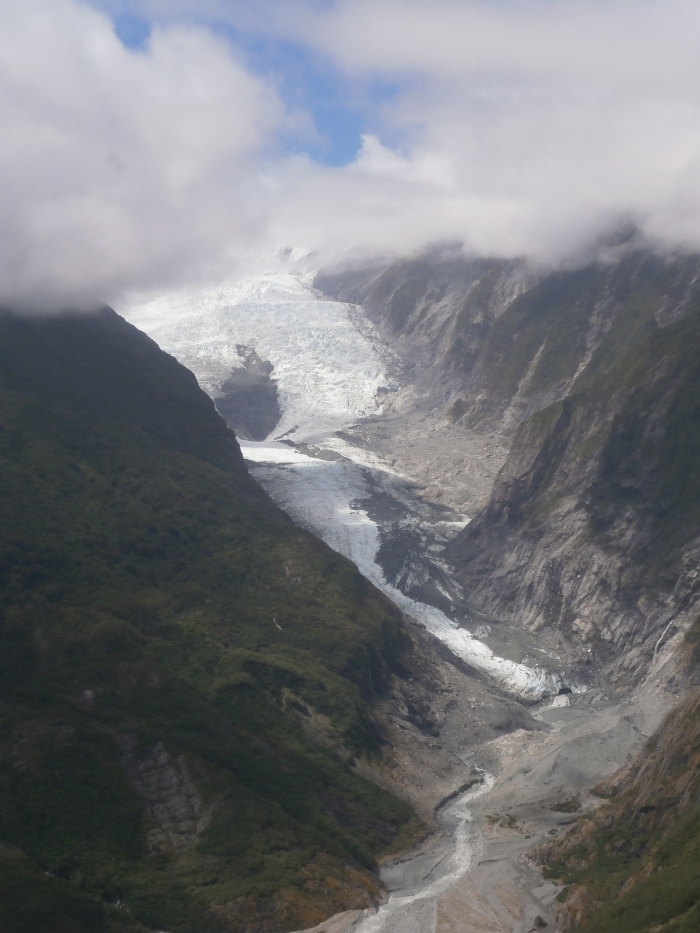We boarded the 8am ferry for Picton – a trip of around three and a half hours across the Cook Strait – to spend a few weeks seeing the best the South Island had to offer. We had a smooth crossing of the open water, and after a few hours, we entered the area of fiords that is the Marlborough Sounds. I went up on deck (or, as the Kiwi accent renders it, “on dick”) and leaned on the rail, enjoying the breeze and the view. It was a stunning day, with the islands and peaks that surrounded us a vivid green against deep turquose water. We landed around lunchtime, and picked up our rental car to see us through the next three weeks. By dint of being willing to drive a 2003 Nissan Sunny, we got a good deal. Since the car was grey, we named it Shadowfax in the hopes that it would show us the meaning of haste.
Our first drive was along the narrow and winding Queen Charlotte Highway, which runs along the rugged north coastline, to the tiny town of Havelock, where we stopped for lunch. Havelock appears to have two main industries: mussels, and tourist tea-shops. We continued to Nelson, which sits on the edge of Abel Tasman National Park on the north coat. Nelson is famous for its lovely Mediterranean climate, and is a centre for outdoorsy activities. We started with a day kayaking and walking in the National Park, which has miles of native bush, walking tracks, and stunning beaches on which storms occasionally dump black sand – pure iron ore from deep-sea trenches. We paddled out to Adele Island, which is maintained as a nature preserve, and saw a tiny fairy penguin shooting through the water. Next was a whole family of seals lounging on the rocks and taking occasional dips. We were learning a good bit about New Zealand’s ecology – principally, the problems caused by its two big pests, the stoat and the Australian possum. Both came from overseas – the possum accidentally, but the stoat was imported from England to try and solve the problem caused by rabbits (also introduced from England). This genius plan went mildly awry, since stoats discovered they could kill native birds and eat their eggs much more easily. “If you see a stoat or a possum in the road,” said our kayaking guide, “it’s your patriotic duty to run it over.”
We picnicked on a beach some way into the park, then trekked back along the Abel Tasman track. The next day, we had planned to drive out to Golden Bay, some way further into the park, but after a sleepless night in our thin-walled hostel we couldn’t face the four-hour round trip, so we spent the day relaxing and walking around central Nelson. We also dropped in on the World of Wearable Art museum, full of weird and wonderful creations made for the annual WoW show, which began in Nelson but has now relocated to Wellington, a victim of its own success.
After a long drive down south the next day, we fetched up in the tiny town of Franz Josef Glacier. What we were there to see needs little explanation. As we got closer, the Southern Alps rose up to become a looming presence to the left; then the streams and rivers started to display the eerie blue of glacier meltwater. The glacier is the only one in the world that occurs within 10km of the sea, and which sprawls down directly into temperate rainforest – an odd, but visually arresting combination. Naturally, we awoke the next day to constant pouring rain, and had to cool our heels and catch up on our sleep for the duration. The next day, after some early cloud, came out fine – and we climbed into helicopters to explore the glacier (it’s too dangerous to walk directly onto it). As the helicopter banked and swooped like a dragonfly, we had amazing views of mountains, sea, and the glacier tumbling down in between the two. We strapped crampons onto our boots and followed our sunburnt Kiwi guide, Ross, up rough steps cut into the ice and into caves marbled with bands of white and frigid blue. As we climbed, the crevasses we traversed got narrower until we had to slide crabwise, unable to put one foot in front of the other, wedged solidly between two sheets of ice.
“Yeah, I love it here,” said Ross. “At weekends we go tramping and camp way up in the hills. Or I go hunting. I kill all my own meat. I never buy meat from the supermarket.”
Once helicoptered safely back down, we spent a little time relaxing in the town’s 40C hot pools, surrounded by rainforest. Then we packed up to take Shadowfax further south to Queenstown.



